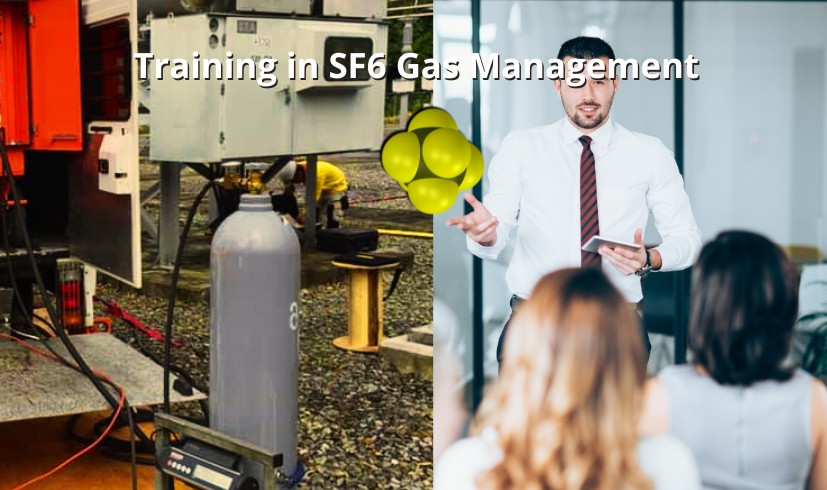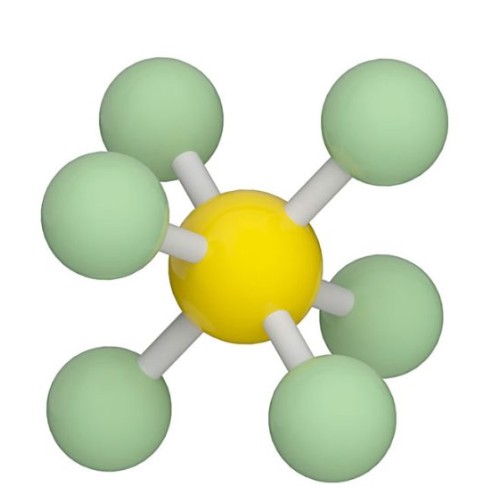
The electrical industry relies heavily on sulfur hexafluoride (SF6) gas for its insulating and arc-quenching properties in high-voltage equipment. However, improper handling poses significant safety and environmental risks. Our SF6 Gas Training Program equips professionals with the expertise to manage this potent greenhouse gas safely, comply with regulations, and protect both personnel and the planet.
Why SF6 Gas Training is Essential
Understanding SF6 Gas
SF6 is a synthetic gas widely used in circuit breakers, switchgear, and transformers. While highly effective, it has a global warming potential 23,500 times greater than CO2, making leaks and mishandling critical concerns.
Risks of Inadequate Training
- Health Hazards: SF6 decomposition products (e.g., toxic byproducts like SO2) can cause respiratory issues.
- Environmental Impact: Uncontrolled emissions contribute significantly to climate change.
- Regulatory Penalties: Non-compliance with EPA, IEEE, and international standards leads to fines.
Comprehensive SF6 Training Curriculum
Course Modules
- SF6 Properties & Applications
- Chemical characteristics, electrical advantages, and industrial uses.
- Health & Safety Protocols
- PPE requirements, ventilation standards, and exposure limits.
- Leak Detection & Mitigation
- Advanced tools (e.g., infrared cameras, gas analyzers) and repair techniques.
- Emergency Response
- Managing gas leaks, evacuation procedures, and first aid.
- Environmental Compliance
- Recycling SF6, disposal guidelines, and reporting under the F-Gas Regulation.
Hands-On Learning
- Gas Handling Labs: Practice filling, recovery, and purification using industry-grade equipment.
- Simulated Scenarios: Respond to leaks, equipment failures, and contamination incidents.
Who Should Attend?
- Electrical Engineers & Technicians
- Substation Operators
- Environmental Health & Safety (EHS) Officers
- Utility Maintenance Teams
Benefits of Certification
- Enhanced Safety: Reduce workplace accidents and health risks.
- Regulatory Adherence: Avoid fines with up-to-date compliance strategies.
- Career Advancement: Gain a competitive edge with accredited expertise.
- Sustainability Leadership: Minimize carbon footprint through responsible gas management.
Industry-Recognized Certification
Upon completion, participants receive a globally recognized SF6 Handling Certification valid for three years. Our program aligns with OSHA, NFPA 70E, and IEC 62271-1 standards.
FAQs: SF6 Gas Training
Q: How long is the training course?
A: Courses range from 1-day workshops to 3-day intensive programs.
Q: Are there prerequisites?
A: Basic electrical knowledge is recommended but not mandatory.
Q: Is SF6 being phased out?
A: While alternatives are emerging, SF6 remains critical; proper handling training is still vital.
Q: Can training be customized for my team?
A: Yes! We offer on-site sessions tailored to your equipment and workflows.
Enroll Now & Lead with Confidence
Equip your team with the skills to handle SF6 gas responsibly. Contact us today to schedule training and join 1,200+ professionals who trust our expertise.
Call-to-Action: “Secure your spot in our next SF6 Gas Safety Workshop – Enroll Now or call (+57) 3168726107!”

Sulfur hexafluoride (SF6) is a colorless, odorless synthetic gas renowned for its exceptional electrical insulating properties. Despite its critical role in powering modern infrastructure, SF6 has come under scrutiny due to its staggering environmental impact. This article explores SF6’s applications, its ecological footprint, and the innovative alternatives shaping a greener future.
What Is SF6 Gas?
SF6 is a fluorinated compound composed of sulfur and six fluorine atoms. First synthesized in 1901, it gained prominence in the mid-20th century for its unique characteristics:
- High Dielectric Strength: 3x superior to air, making it ideal for electrical insulation.
- Chemical Stability: Non-flammable, non-toxic, and inert under normal conditions.
- Thermal Conductivity: Efficient in cooling high-voltage equipment.
These properties have cemented SF6 as a cornerstone of electrical and industrial applications.
Key Applications of SF6 Gas
1. Electrical Power Systems
SF6 is the lifeblood of high-voltage switchgear, circuit breakers, and gas-insulated substations (GIS). It prevents dangerous arcs, ensuring grid reliability in urban centers and renewable energy systems like wind turbines.
2. Medical and Scientific Uses
In healthcare, SF6 stabilizes retinal surgeries and enhances ultrasound imaging. Laboratories leverage it for particle acceleration and plasma etching in semiconductor manufacturing.
3. Industrial Processes
SF6 insulates magnesium production furnaces and acts as a tracer gas for detecting leaks in pipelines and HVAC systems.
The Environmental Paradox of SF6
While SF6 boosts industrial efficiency, it’s the most potent greenhouse gas ever evaluated:
- Global Warming Potential (GWP): 23,500x greater than CO2 over a 100-year period.
- Long Atmospheric Lifespan: Persists for 3,200 years, exacerbating climate change.
According to the Intergovernmental Panel on Climate Change (IPCC), SF6 concentrations have surged by 40% since 2000, driven by expanding electrical grids and renewable energy infrastructure.
Regulatory Actions and Industry Shifts
The Kyoto Protocol classifies SF6 as a regulated greenhouse gas, prompting global mitigation efforts. The European Union’s F-Gas Regulation mandates phasedown targets, pushing industries to adopt alternatives.
Innovative Substitutes Gaining Traction:
- Fluoronitrile-Based Gases: GE’s g3 gas reduces GWP by 98% in high-voltage gear.
- Dry Air or Nitrogen: Effective for medium-voltage applications.
- CO2 Blends: Emerging in circuit breakers for lower environmental impact.
Companies like Siemens and ABB now offer SF6-free switchgear, aligning with sustainability goals.
Best Practices for SF6 Management
- Leak Detection: Regular monitoring using infrared cameras.
- Recycling: Purification and reuse to minimize virgin SF6 production.
- Training: Ensuring technicians follow protocols for handling and disposal.
The EPA’s SF6 Emission Reduction Partnership has cut U.S. emissions by 60% since 1999 through such strategies.
The Road Ahead: Balancing Progress and Sustainability
The transition to SF6 alternatives faces hurdles, including higher costs and technical limitations. However, stricter regulations and corporate ESG commitments are accelerating R&D. Europe aims to eliminate SF6 in medium-voltage equipment by 2030, signaling a paradigm shift.
Future Innovations to Watch:
- Solid Insulation: Eco-friendly polymers for compact switchgear.
- Digital Monitoring: IoT sensors for real-time gas tracking.
Conclusion
SF6 gas remains indispensable to global electrification, yet its environmental toll demands urgent action. By embracing alternatives, enhancing recycling, and adhering to regulations, industries can mitigate climate risks while maintaining operational excellence. The journey to replace SF6 is not just a technical challenge—it’s a critical step toward a sustainable energy future.

Understanding SF6 Gas: Its Importance and Applications
SF6 gas, or sulfur hexafluoride, is a colorless, odorless, non-toxic gas that has become integral in various industrial applications, particularly in the energy sector. One of its most notable properties is its outstanding dielectric strength, which enables it to effectively insulate electrical components. Due to this property, we are global SF6 gas marketers and recognize its critical role in maintaining the safety and reliability of equipment. SF6 is commonly utilized in electrical insulation for high-voltage circuit breakers, switchgear, and other high-voltage equipment.
The chemical stability of SF6 gas is another reason for its popularity in industrial applications. It does not react with other substances under normal conditions, which minimizes the risk of electrical arcing and enhances operational safety. This inertness allows for effective performance in extreme conditions, further securing its position in essential energy infrastructure. With the electrical grid’s complexity growing and the demand for reliable energy supply increasing, SF6 gas emerges as a pivotal element in ensuring electrical safety and efficiency.
Moreover, SF6 gas excels in preventing electrical accidents. In high-voltage environments, even small failures can result in considerable hazards, including equipment damage and potential safety risks. The use of SF6 gas in circuit breakers and insulation systems drastically reduces such risks, making it a preferred choice among utilities and energy producers. The advantages provided by SF6 gas significantly enhance grid reliability, promoting uninterrupted power supply and reducing maintenance costs. Given these factors, it is evident that SF6 gas is not only crucial in the energy sector but also finds applications in various other industries, such as semiconductor manufacturing and particle accelerators, where its unique properties are indispensable.
The Role of Global Marketers in SF6 Gas Distribution
The distribution of sulfur hexafluoride (SF6) gas represents a critical component in various industrial sectors, most notably in electrical insulation and high-voltage applications. As global SF6 gas marketers, the role encompasses a wide array of functions that ensure not only the efficiency of supply chains but also the compliance with environmental regulations. Effective global marketing strategies enable marketers to maintain a steady flow of SF6 gas from manufacturers to end-users, which is essential given the compound’s specialized applications.
One of the foremost challenges in SF6 gas distribution is navigating the complexities of regulatory frameworks across different regions. Various countries have implemented stringent guidelines concerning the handling and usage of SF6 due to its high global warming potential. Global marketers play a pivotal role in educating stakeholders about these regulations and ensuring that the supplied SF6 gas adheres to the mandated standards. This involves developing a comprehensive understanding of both local and international laws, which can vary significantly.
Another challenge faced by global SF6 gas marketers is the need for establishing and maintaining strategic partnerships. Collaborations with manufacturers, logistics providers, and end-users can facilitate smoother operations and enhance the reliability of supply. By building strong relationships, global marketers can create a robust network that mitigates risks associated with supply chain disruptions, thus ensuring that SF6 gas remains accessible to industries that depend on it.
Furthermore, the importance of responding to market demands cannot be overstated. As the energy sector evolves, so do the needs for SF6 gas, leading to ongoing innovations in its production and distribution. Marketers must stay attuned to these shifts, adopting flexible strategies that cater to the changing landscape, ensuring that both the supply and demand elements of SF6 gas distribution are effectively aligned.
Sustainability and Regulation: Navigating the Challenges of SF6 Gas
The environmental implications of SF6 gas usage are significant due to its exceptionally high global warming potential, which is reported to be over 22,000 times that of carbon dioxide over a 100-year period. As global SF6 gas marketers, it is imperative to acknowledge these concerns and engage in proactive strategies aimed at minimizing emissions. The electrical industry, particularly in the realm of circuit breakers and switchgear, has been a major consumer of SF6, prompting regulatory scrutiny to ensure responsible usage and management.
Various international and national regulations have emerged targeting the reduction of SF6 emissions. The European Union has established stringent rules under the F-gas Regulation, which aims to phase down the use of fluorinated gases, including SF6, in favor of more environmentally friendly alternatives. Moreover, many countries have created voluntary initiatives encouraging industries to adopt best practices in SF6 management. These regulations serve as a crucial framework for global marketers, guiding them in implementing compliant and sustainable practices during the handling, usage, and disposal of SF6 gas.
To tackle the challenges posed by SF6, numerous innovative strategies and technologies are being developed. Research is focusing on alternatives to SF6, such as vacuum technology and air-insulated switchgear, which not only reduce environmental impact but also enhance operational efficiency. Additionally, improved monitoring and leak detection technologies are gaining prominence, allowing for the precise measurement of emissions and the implementation of immediate remedial actions when necessary. As responsible global SF6 gas marketers, leveraging these technologies is vital to reducing reliance on SF6 while continuing to fulfill industrial requirements sustainably.
Through these comprehensive approaches encompassing regulation compliance, sustainable practices, and innovative technologies, the SF6 industry can navigate the environmental challenges associated with this potent greenhouse gas. The commitment to shaping a sustainable future is not merely an obligation; it is an opportunity for global marketers to lead in the transition toward responsible and ecological stewardship within the sector.
The Future of SF6 Gas Marketing: Trends and Innovations
The landscape of SF6 gas marketing is ever-evolving, where technological advancements and market dynamics play crucial roles in shaping its future. As the focus on sustainability intensifies globally, marketers are finding innovative ways to adapt their strategies and offerings. One significant trend is the increasing interest in alternatives to SF6 gases. In light of regulatory pressures and environmental concerns, research and development are being directed towards sulfur hexafluoride substitutes that offer similar performance levels but with lower environmental impacts. This shift is expected to drive the creation of new market segments and opportunities for global SF6 gas marketers.
Moreover, projections for market growth indicate a steady demand for SF6 gas, especially in specific industries such as power generation and electrical transmission. As nations continue to invest in renewable energy sources, SF6’s role as a high-voltage insulator will remain critical. Consequently, the global SF6 gas marketers will need to monitor industry trends carefully to align their product offerings with emerging needs and regulatory frameworks.
The adoption of digital marketing strategies is another pivotal trend in the SF6 gas marketing sector. With the increasing reliance on online platforms for information and purchasing decisions, marketers must engage more effectively through digital channels. This includes the utilization of search engine optimization (SEO), content marketing, and social media campaigns to enhance brand visibility and connect with stakeholders. Implementing data analytics will also enable marketers to gain insights into customer behavior, helping tailor their messages and strategies to better align with market demands.
In conclusion, the future of SF6 gas marketing is poised for transformation, driven by innovation, regulatory requirements, and the growing urgency for sustainable practices. Global marketers must remain proactive and adaptable, utilizing new technologies and strategies to thrive in this rapidly changing environment.



